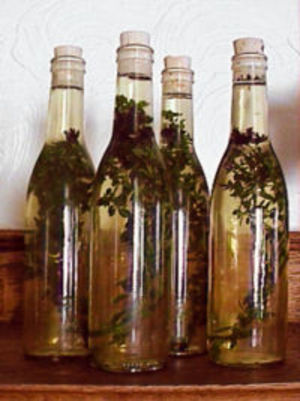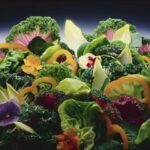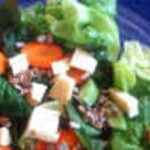Making a light vinaigrette is a simple technique that is not difficult to master. Once you realize how easy it is you will be able to create your own variations to use as dressings, marinades, dips, sauces, and more. I learned from my years of cooking in restaurants that classic vinaigrettes use a ratio of 2:1 oil to vinegar. While this creates a rich and creamy emulsified vinaigrette, the oil also adds a lot of fat and calories.
The first thing to understand is that there are as many types of vinaigrette as there are cooks. First you must decide what you want to create and how it will blend with your dish. It’s always best to stay fairly simple and straightforward. This type of dressing doesn’t need a lot of ingredients to taste fresh and delicious. If you have lots of lemons then make a light lemon vinaigrette. If you want to dress red meat, pork, or lamb then a darker, richer balsamic dressing might be in order. For sub sandwiches or a dinner salad perhaps a red wine vinaigrette will work better.
Assemble all of your ingredients together. The best way to make a light vinaigrette that blends together well is in a blender or food processor. The best basic recipe is to put the following into a blender: a clove of garlic or shallot, ¼ cup fresh lemon juice, ¼ cup white wine vinegar, the zest of a lemon, 2 tablespoons honey, 2 tablespoons good quality EV olive oil, salt and pepper to taste, and chopped fresh herbs such as one or more of the following: basil, tarragon, rosemary, thyme, mint, and/or Italian parsley. Puree for 30 seconds until all of the ingredients are blended together. This vinaigrette keeps well in the refrigerator for 3-4 days.
You can experiment with ingredients and find that vinaigrette is a very forgiving medium. If you add too much salt or sweet you can adjust with a counterbalance of flavor. For example if you add too much garlic you can add more acid and a little more oil. If you add in a strong ingredient such as anchovies or capers and decide the taste is too intense you can leaven it by adding a dollop of light sour cream or lowfat yogurt.
Try using unusual or herb flavored vinegars, such as white balsamic, Meyer lemon, or raspberry vinegar, or vinegars infused with herbs and other flavors. There are also a lot of interesting oils such as herb infused olive oils, walnut oil, truffle oil, citrus olive oil, and many more. Different mustards are also outstanding in small doses, such as Dijon, honey mustard, coarsely ground, spicy brown, and more.
Think about the type of meal you want to create. If you’re cooking Asian style cuisine think about a light Japanese or Thai vinaigrette. For Indian food consider adding a few traditional Indian spices into the vinaigrette such as garam masala, curry, or cinnamon and coriander. Just remember to use dried spices lightly in vinaigrette, as a little goes a long way.
Vinaigrettes can be used for more than just salad dressings or marinades. Add them to sautés, sauces, casseroles, soups, and more for deeper levels of flavor and texture.
When you master the technique of making light vinaigrette you will be able to add layers of flavor to all of you meals. Your creativity will take over and allow you to make dressings, marinades, and sauces that make all of your meals soar to the next extraordinary level.







